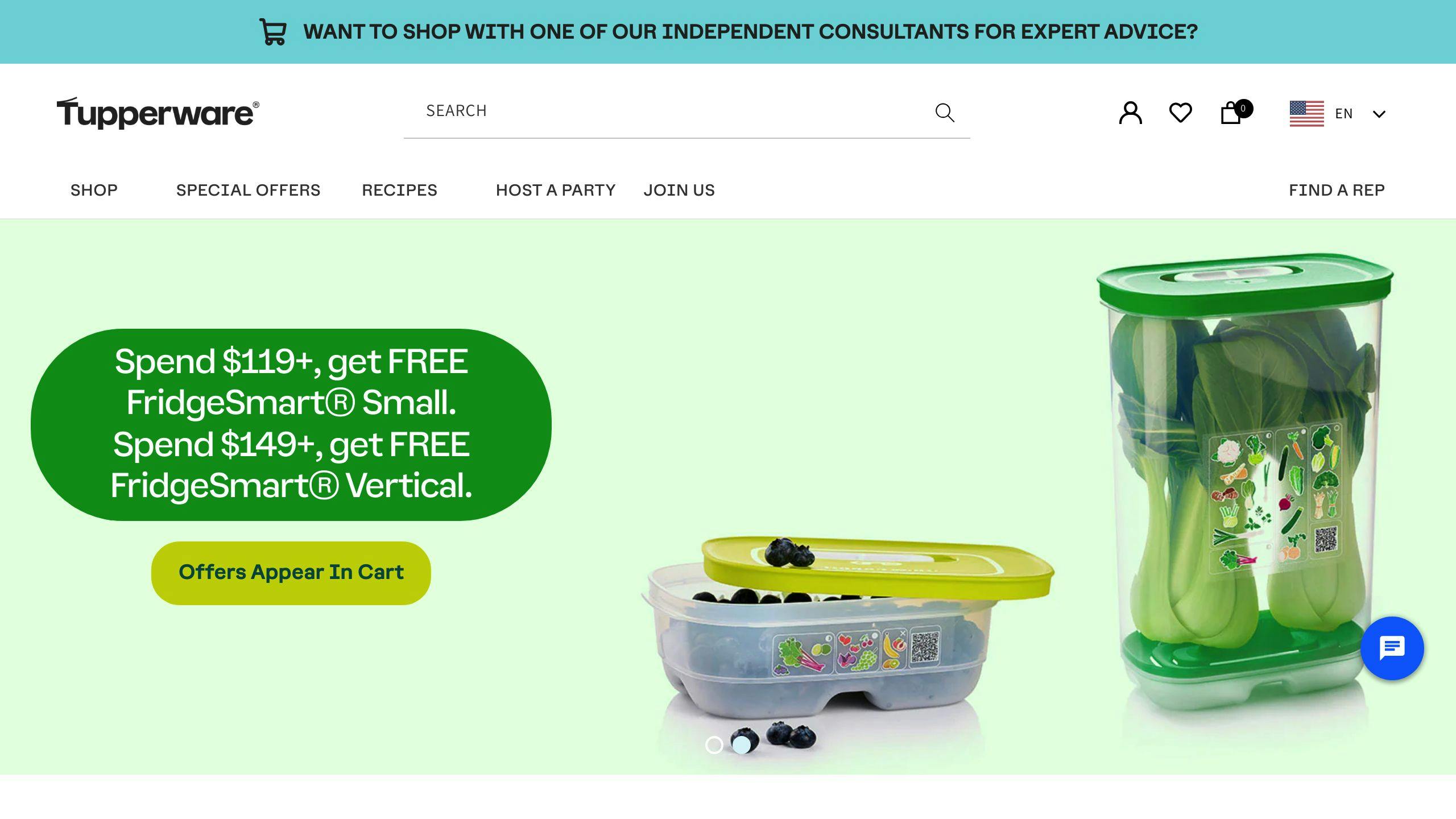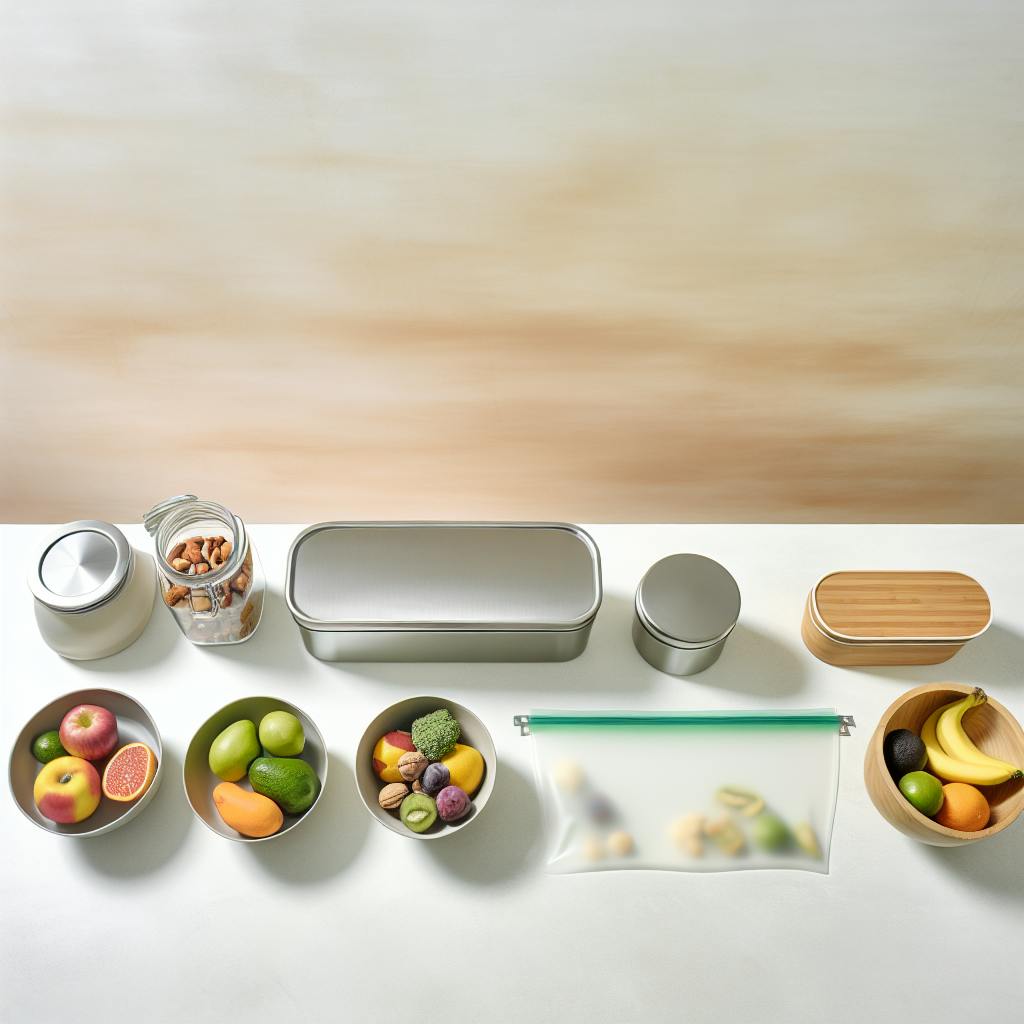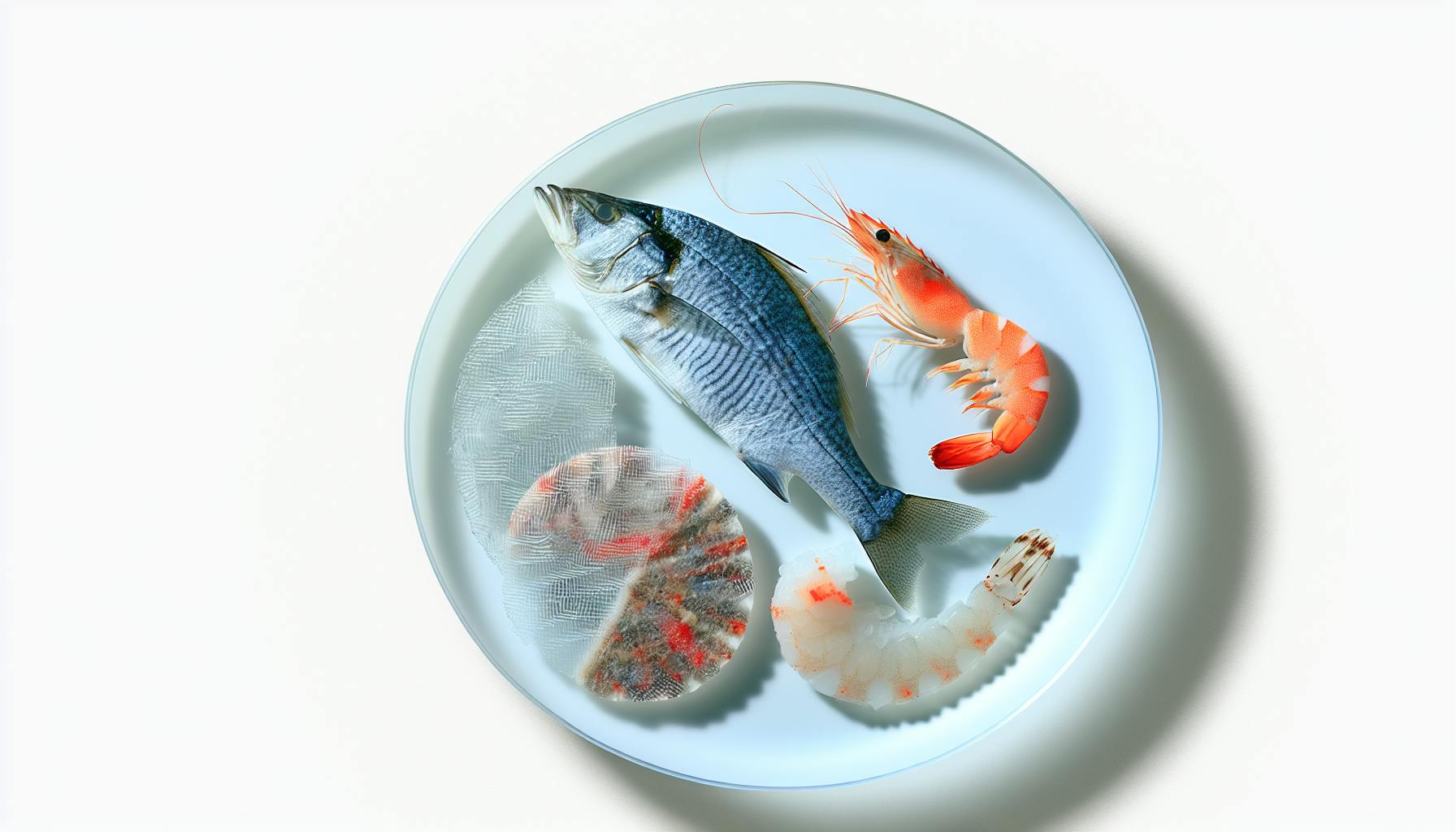Microplastics are tiny plastic particles smaller than 5 millimeters that can contaminate our food and drinks from everyday items like plastic containers. This is a growing concern for our health and the environment.
Key Points:
- Plastic containers can release microplastics into food, especially when heated, scratched, or old
- Microplastics may cause health issues like toxic chemical exposure, hormone imbalances, inflammation, and buildup in the body
- Safer options for food storage include glass, stainless steel, silicone, and beeswax wraps, which are less likely to release microplastics
What You Can Do:
- Replace plastic containers with safer alternatives like glass, stainless steel, or silicone
- Avoid heating food in plastic containers
- Inspect and replace old, scratched, or discolored plastic containers
- Clean containers properly following manufacturer's instructions
- Choose eco-friendly options like beeswax wraps or reusable silicone bags
Safer Alternatives:
| Material | Advantages |
|---|---|
| Glass | Non-porous, microwave-safe, dishwasher-safe, freezer-safe, oven-safe, stain-resistant, odor-resistant, recyclable, reusable |
| Stainless Steel | Non-reactive, durable, lightweight, corrosion-resistant, oven-safe, dishwasher-safe, easy to clean |
| Silicone | Non-toxic, BPA-free, phthalate-free, flexible, heat-resistant, freezer-safe, microwave-safe, oven-safe, dishwasher-safe |
| Beeswax Wraps | Sustainable, eco-friendly, breathable, reusable, washable, biodegradable, compostable |
By making these simple changes, you can minimize your exposure to microplastics and protect your health while also reducing plastic waste.
Related video from YouTube
Defining Microplastics
Microplastics are tiny plastic particles or fibers less than 5 millimeters (0.2 inches) in size. They are classified into two main types based on their origin:
Types of Microplastics
1. Microplastics Made Tiny
These microplastics are intentionally manufactured to be microscopic in size, including:
- Microbeads: Tiny plastic beads used as exfoliants in cosmetic products like facial scrubs and toothpaste.
- Nurdles: Small plastic pellets used as raw materials for making larger plastic products.
2. Microplastics from Larger Plastics
These microplastics form when larger plastic items break down over time due to exposure to environmental factors like sunlight, wind, and waves. Examples include:
- Fragments from plastic bags, bottles, and other single-use plastics.
- Microfibers shed from synthetic clothing and textiles during washing or wear.
- Particles from the degradation of fishing nets, ropes, and other marine equipment.
Sources and Presence
Microplastics are widespread in the environment due to their extensive use and improper disposal of plastic waste. Common sources include:
| Source | Examples |
|---|---|
| Plastic Packaging | Food containers, bottles, and other single-use plastics |
| Synthetic Textiles | Clothing and fabrics made from materials like polyester and nylon |
| Cosmetic Products | Facial scrubs, toothpaste, and other personal care items with microbeads |
| Industrial Processes | Plastic pellets used in manufacturing |
Microplastics have been found in various ecosystems, including oceans, rivers, soil, and even the air we breathe. Their small size and persistence make them difficult to remove from the environment, leading to widespread contamination and potential risks to human health and wildlife.
Microplastics in Food Containers
How Microplastics Get Released
Plastic food containers can release tiny plastic particles called microplastics into your food and drinks, especially when heated or used over a long time. Here's how it happens:
- Microwaving: Heating plastic containers in the microwave can cause thousands to billions of microplastic particles to break off and get into your food.
- Long-Term Storage: Storing food in plastic containers for over six months, even at room temperature or in the fridge, can lead to millions to billions of microplastics and even smaller nanoplastics contaminating your food.
- Wear and Tear: Old, scratched, or damaged plastic containers are more likely to shed microplastics into the food they hold because the plastic material has broken down.
Factors That Affect Microplastic Release
Some factors make it more likely for microplastics to leach from food containers:
| Container Material | Details |
|---|---|
| Polypropylene (PP) | Studies found 3 to 43 microplastic particles, mostly PP fibers, in PP takeaway containers. |
| Polyethylene (PE) | Some food-grade PE plastic bags can release toxic chemicals like nonylphenol, a common plastic additive. |
| Container Age & Condition | Details |
|---|---|
| Older Containers | Worn-out or damaged containers are more prone to releasing microplastics as the plastic breaks down over time. |
| Signs of Wear | Visible scratches, cracks, or discoloration can indicate an increased risk of microplastic leaching. |
| Usage Patterns | Details |
|---|---|
| Repeated Heating | Microwaving or heating plastic containers repeatedly can speed up the release of microplastics. |
| Fatty or Acidic Foods | Storing these types of foods in plastic containers can cause the plastic to degrade faster, leading to more microplastic leaching. |
To reduce your exposure to microplastics from food containers, consider the container material, age, and how you use it. When possible, choose safer alternatives like glass, stainless steel, or silicone containers.
Health Risks of Microplastics
Toxic Chemical Exposure
Microplastics can carry harmful chemicals like bisphenol A (BPA), phthalates, and other additives used in plastic production. Ingesting these chemicals through microplastic contamination has been linked to:
- Organ Damage: Chemicals from microplastics may build up in organs like the liver and kidneys, potentially causing damage over time.
- Hormone Disruption: Many plastic additives can interfere with hormone production and regulation, increasing the risk of reproductive issues, developmental problems, and certain cancers.
- Neurotoxicity: Some chemicals found in microplastics, such as flame retardants, have been associated with harmful effects on brain development and function.
Hormone Imbalance
Several studies have identified microplastics as substances that can mimic or disrupt the body's natural hormones. This disruption can lead to various health issues:
| Hormone | Potential Effects |
|---|---|
| Estrogen | Reproductive problems, increased breast cancer risk, early puberty |
| Testosterone | Impaired fertility, developmental defects, prostate issues |
| Insulin | Increased risk of diabetes, metabolic disorders |
Even at moderate exposure levels, microplastics have been shown to alter sex hormone levels, highlighting the need for further research into their long-term impacts on human health.
Inflammation and Immune Effects
Microplastic ingestion has been linked to inflammatory responses and immune system disruption in various studies:
- Inflammation: Microplastics can trigger inflammation in the gut and other tissues, potentially contributing to chronic inflammatory conditions like inflammatory bowel disease (IBD) and rheumatoid arthritis.
- Immune Suppression: Some research suggests that microplastics may suppress immune function, making individuals more susceptible to infections and diseases.
- Allergic Reactions: The presence of microplastics in the body may also increase the risk of allergic reactions or exacerbate existing allergies.
Accumulation in the Body
As microplastics are ingested through food, water, and air, they can accumulate in various organs and tissues over time, a process known as bioaccumulation. Studies have detected microplastics in:
- Digestive System: Microplastics have been found in the gut, liver, and kidneys, potentially causing physical damage and toxicity.
- Circulatory System: Smaller microplastics can translocate across the gut and enter the bloodstream, allowing them to circulate throughout the body.
- Respiratory System: Inhaled microplastics may become lodged in the lungs or potentially travel to other organs through the circulatory system.
- Brain: Alarmingly, microplastics have even been detected in brain tissue, suggesting they can cross the blood-brain barrier, a protective mechanism against foreign substances.
The long-term effects of this bioaccumulation are still being investigated, but concerns exist regarding the potential for chronic health issues and biomagnification through the food chain.
sbb-itb-1dc3f59
Identifying Risky Containers
Plastic Types to Avoid
Some plastics are more likely to release tiny plastic particles (microplastics) and chemicals into your food and drinks. Here are plastic materials to avoid for food storage:
| Plastic Type | Resin Code | Risk Level |
|---|---|---|
| Polyvinyl Chloride (PVC) | #3 | High |
| Polycarbonate (PC) | #7 | High |
| Polystyrene (PS) | #6 | Moderate to High |
| Polyethylene Terephthalate (PET) | #1 | Moderate |
PVC and polycarbonate plastics can contain harmful additives like phthalates and bisphenol A (BPA). These chemicals can leach into food and drinks, especially when heated or exposed to acidic substances. Polystyrene, used in disposable food containers, can also release styrene, a potential cancer-causing substance.
Signs of Wear and Tear
Even safer plastics for food storage can become risky if they show signs of wear and tear. Here are some indicators that a plastic container may be releasing microplastics:
-
Cracks or Crazing: Small cracks or a network of fine cracks on the container's surface can allow chemicals and microplastics to leach into the contents.
-
Cloudiness or Discoloration: A once-clear plastic container that has become cloudy or discolored may be degrading, increasing the risk of microplastic release.
-
Scratches or Abrasions: Deep scratches or abrasions on the surface can create pathways for microplastics to migrate into food or liquids.
-
Warping or Melting: Containers that have been exposed to high heat or have melted or warped areas are more likely to release microplastics and chemicals.
-
Age: Older plastic containers, especially those manufactured before the phase-out of certain harmful additives like BPA, may be more prone to leaching microplastics and chemicals over time.
If you notice any of these signs, it's best to replace the container with a safer alternative to minimize your exposure to microplastics and potential health risks.
Safe Food Storage Options
Glass Containers
Glass containers are an excellent choice for storing food safely. They are non-porous, meaning they won't absorb odors, flavors, or chemicals from the food inside. Glass is also durable, heat-resistant, and can be used in the microwave and dishwasher.
| Feature | Glass Containers |
|---|---|
| Material | Non-porous, inert |
| Microwave-safe | Yes |
| Dishwasher-safe | Yes |
| Freezer-safe | Yes |
| Oven-safe | Yes (up to certain temperatures) |
| Stain-resistant | Yes |
| Odor-resistant | Yes |
| Eco-friendly | Recyclable and reusable |
Glass containers are a versatile and safe option for storing leftovers, packing lunches, and preserving freshness. They are easy to clean and maintain, and their transparency allows you to see the contents without opening the container.
Stainless Steel Containers
Stainless steel is another excellent option for food storage. It is non-reactive, meaning it won't interact with or leach chemicals into your food. Stainless steel containers are durable, lightweight, and resistant to corrosion and rust.
While stainless steel containers are not microwave-safe, they are oven-safe and can withstand high temperatures. They are also dishwasher-safe and easy to clean, making them a convenient choice for storing and transporting food.
Silicone Containers
Silicone containers are a popular alternative to plastic due to their flexibility, heat resistance, and ability to withstand freezing temperatures. They are made from a synthetic rubber-like material that is non-toxic and free from harmful chemicals like BPA and phthalates.
Silicone containers are versatile and can be used for storing, cooking, and serving food. They are microwave-safe, oven-safe, and dishwasher-safe, making them easy to clean and maintain. Silicone containers are also flexible, which makes them ideal for storing and transporting food without spills or leaks.
Beeswax Wraps
Beeswax wraps are a sustainable and eco-friendly alternative to plastic wrap. They are made from cotton fabric coated with beeswax, which creates a breathable and malleable cover for food. Beeswax wraps can be used to cover bowls, wrap sandwiches, and store fruits and vegetables.
Unlike plastic wrap, beeswax wraps are reusable and can be washed and reused multiple times. They are also biodegradable and compostable, making them an environmentally friendly choice for food storage.
Reducing Microplastic Exposure
Avoid Heating in Plastic
Heating food or drinks in plastic containers can cause tiny plastic particles (microplastics) to break off and get into your food. To minimize exposure, avoid microwaving or heating food in plastic containers. Instead, use microwave-safe glass, ceramic, or stainless steel containers. These materials won't release harmful chemicals or microplastics when heated.
Proper Cleaning and Care
Regular and thorough cleaning of food storage containers can help reduce microplastic release. For glass and stainless steel containers, use mild detergent and warm water, avoiding abrasive pads or harsh chemicals that can scratch the surface. Follow the manufacturer's instructions for cleaning and drying silicone containers. Gently wash beeswax wraps with cold water and mild soap, and air-dry them.
Regular Replacement
Over time, plastic containers can degrade and release more microplastics, even at room temperature. Replace plastic containers regularly, especially if they show signs of wear and tear, such as scratches, cracks, or discoloration. Consider replacing them every 6-12 months, or sooner if they appear damaged.
Choosing Safer Materials
When selecting food storage containers, prioritize safer materials like glass, stainless steel, or silicone. These materials are non-toxic, durable, and less likely to release microplastics or harmful chemicals into your food. Gradually replace your plastic containers with these safer alternatives, and look for containers labeled as BPA-free, phthalate-free, and microwave-safe.
Additionally, consider eco-friendly options like beeswax wraps or reusable silicone bags, which can reduce your reliance on single-use plastics and minimize your exposure to microplastics.
| Material | Advantages |
|---|---|
| Glass | Non-porous, inert, microwave-safe, dishwasher-safe, freezer-safe, oven-safe (up to certain temperatures), stain-resistant, odor-resistant, recyclable, and reusable |
| Stainless Steel | Non-reactive, durable, lightweight, corrosion-resistant, oven-safe, dishwasher-safe, easy to clean |
| Silicone | Non-toxic, BPA-free, phthalate-free, flexible, heat-resistant, freezer-safe, microwave-safe, oven-safe, dishwasher-safe |
| Beeswax Wraps | Sustainable, eco-friendly, breathable, malleable, reusable, washable, biodegradable, compostable |
Conclusion
The Microplastic Problem
Microplastics are tiny plastic particles that can get into our food and drinks from everyday items like plastic food containers. This is a growing concern for our health and the environment.
Key Points
- Plastic containers can release microplastics into food, especially when heated, scratched, or old.
- Microplastics may cause health issues like toxic chemical exposure, hormone imbalances, inflammation, and buildup in the body.
- Safer options for food storage include glass, stainless steel, silicone, and beeswax wraps, which are less likely to release microplastics.
- Proper cleaning, regular replacement, and avoiding heating in plastic containers can help reduce microplastic exposure.
What You Can Do
1. Replace plastic containers
Gradually switch to glass, stainless steel, or silicone containers, especially for storing and reheating food.
2. Avoid heating food in plastic
Use microwave-safe glass, ceramic, or stainless steel containers instead of plastic to prevent microplastic leaching.
3. Inspect and replace old containers
Check plastic containers regularly and replace them if they show signs of wear, such as scratches, cracks, or discoloration.
4. Clean containers properly
Follow the manufacturer's instructions to clean and care for reusable containers, extending their lifespan and minimizing microplastic release.
5. Choose eco-friendly options
Consider beeswax wraps or reusable silicone bags to reduce single-use plastics and minimize microplastic exposure.
Safer Alternatives
| Material | Advantages |
|---|---|
| Glass | Non-porous, microwave-safe, dishwasher-safe, freezer-safe, oven-safe, stain-resistant, odor-resistant, recyclable, reusable |
| Stainless Steel | Non-reactive, durable, lightweight, corrosion-resistant, oven-safe, dishwasher-safe, easy to clean |
| Silicone | Non-toxic, BPA-free, phthalate-free, flexible, heat-resistant, freezer-safe, microwave-safe, oven-safe, dishwasher-safe |
| Beeswax Wraps | Sustainable, eco-friendly, breathable, reusable, washable, biodegradable, compostable |
FAQs
Should I avoid plastic Tupperware?

While plastic Tupperware containers are convenient and widely used, it's best to phase them out gradually and replace them with safer options due to the potential risks of microplastic exposure.
Plastic containers, especially older or scratched ones, can release tiny plastic particles (microplastics) into food, especially when heated or microwaved. These microplastics may pose health risks, such as:
- Exposure to toxic chemicals
- Hormone disruption
- Inflammation and immune system effects
- Buildup in the body
To minimize microplastic exposure, consider switching to:
| Alternative | Benefits |
|---|---|
| Glass containers | Non-porous, microwave-safe, dishwasher-safe, freezer-safe, oven-safe, stain-resistant, odor-resistant, recyclable, reusable |
| Stainless steel containers | Non-reactive, durable, lightweight, corrosion-resistant, oven-safe, dishwasher-safe, easy to clean |
| Silicone containers | Non-toxic, free from BPA and phthalates, flexible, heat-resistant, freezer-safe, microwave-safe, oven-safe, dishwasher-safe |
| Beeswax wraps | Sustainable, eco-friendly, breathable, reusable, washable, biodegradable, compostable |
Additionally:
- Avoid heating or microwaving food in plastic containers.
- Replace old, scratched, or discolored containers regularly.
- Proper cleaning and care can help extend the lifespan of reusable containers and minimize microplastic release.


